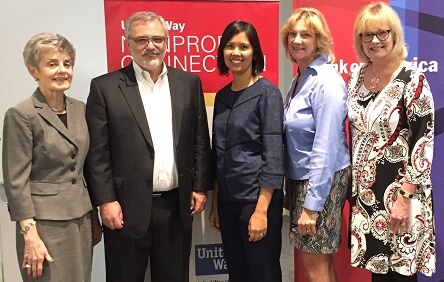Disaster-Ready Strategy: How Can We Be Best Prepared?
Imagine running a homeless youth center for the most at-risk runaways in a major metro area, and it has flooded, so now there are not even functioning bathrooms and total repairs will run into the millions.
Or you run an advocacy group for the disabled, and every family you serve has lost their equipment in the disaster, some of which are life-sustaining apparatuses.
Or you mobilize church volunteers to help house the homeless, and now half the city is homeless.
These are just a few of the new realities facing nonprofits in the Houston area following the four-day deluge brought by Hurricane Harvey.
On October 11, United Way of Greater Houston hosted a strategy workshop for area nonprofits that offered an opportunity to share some of these challenges and join together to think about how to craft strategy in a way that adapts to the unexpected. The session was attended by at least 50 nonprofit leaders and featured panelists from three affected organizations and a keynote presentation by David La Piana.

[Pictured, left to right: Ronnie Hagerty of United Way of Greater Houston, David La Piana of La Piana Consulting, and event panelists Sonja Gee of Main Street Ministries Houston, Mary Jane Williams of Family to Family Network, and Leslie Bourne of Covenant House Texas. Photo courtesy of United Way of Greater Houston.]
La Piana’s message is that strategy, while still the most powerful tool in a nonprofit’s toolbox, must remain flexible. Even without an epic flood, the world is dangerous and unpredictable, change comes at a rapid pace, and nonprofits must be ready.
For example, urged by its board chair, Main Street Ministries prefers to hire strategic thinkers who constantly engage with one another and the board in generative, “what if” discussions, and practice rapid response to changing circumstances over creating a fixed strategic plan. This paid off when a potential donor called after the storm and asked, “How soon can you start delivering services?” Sonja Gee, CEO, was able to answer: “We have already begun,” and a substantial gift was made. To quickly mobilize its volunteer workforce, Main Street Ministries had to delay opening a long-planned new service, but it didn’t hesitate to make this choice. Immediate needs came first.
Response to the disaster has reflected the generosity of the community, and indeed the entire country, bringing national media attention, re-energizing donor bases, and yielding heartfelt in-kind contributions to help meet affected residents’ day-to-day needs. On the other hand, all realize that this level of support will be fleeting and that all the community’s pre-Harvey social problems remain. At the same time, nonprofits with missions unrelated to the flood have seen contributions drop as focus is drawn to emergency response and recovery activities.
In recent weeks, many have shared insights and resources for nonprofits and foundations related to disaster readiness, response, and recovery. We’d like to amplify just a few of these:
Network for Good recently offered data on disaster-giving patterns, along with these practical tips: 1) Stay prepared, by periodically checking to make sure online donation forms are working and having pre-written email templates ready to quickly edit and send to donors within two weeks of an emergency. 2) Follow up with donors after they have contributed, by sending meaningful “thank you” messages, together with ongoing updates throughout the recovery effort, so that they feel engaged and are likely to give the next time disaster strikes. In Houston, we also heard other ideas, including: update your disaster plan periodically, and migrate all your critical data to the cloud so that if facilities and/or equipment is destroyed you can recover data remotely and staff can do critical work from home, or even a temporary shelter.
We are also intrigued by unorthodox experiments, such as GiveDirectly‘s decision to apply its individual cash card distribution model used in Africa to assist some of the most hard-hit residents just outside of Houston. In extraordinary circumstances such as natural disasters, it is perhaps just these sorts of exceptional responses that are in order.
And don’t miss the upcoming report on “The State of Disaster Philanthropy” from The Foundation Center and The Center for Disaster Philanthropy later this month, and sign up for a free webinar to review report highlights on November 8.

